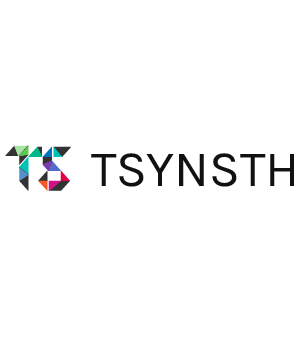
Tuning Synesthesia (tSynsth, TS) is an interdisciplinary team of designers and engineers, designeers, dedicated to application of computational design in various fields of design, placing much emphasis on a sustainable identity in design and its development.
It was originally started in 2012 as a team of freelancers by Chie Fuyukiand in 2016 it was then established as a registered architectural design firm 系联建筑设计咨询(北京)有限公司 in Beijing, China.
The team focuses on a thorough and proactive research of existing systems and design prototypes for application in design and architecture practice; the result of which has been publicly acclaimed in the format of a series of computational design workshops held successfully in Beijing in the year 2016. The team expertise extends to several areas in interdisciplinary system research, including architecture, computer science, nature science, literature, art and music; and applied to master planning, architectural design, building skin standardization, landscape design, and web application. As specialized consultants in computational design, the team has collaborated on projects with many global and domestic firms, some of which have been awarded notable recognition, both practical and academic.
システムと共感覚デザイン(Tuning Synesthesia)は2012年にコンピューティングを軸とした学際的な研究且つデザインフリーランスのチームとして冬木千枝によって結成された。2016年に建築設計事務所として登録、北京でこれまで手掛けてきたプロジェクトは多種にわたる。デザインの範囲は建築の設計プロジェクト、コンピュテーショナル・デザイン関連のコンサルタント業務やウェブデザイン業務、特に建築設計においては室内設計、商業建築・公共建築から都市デザインが含まれる。
これまでの主なクライエントはアリババ株式会社、中国の不動産会社[Sino-Ocean Group Holding Limited 遠洋地産]やエンジニアリング・コンサルティング会社[CCDI中建国際]、中国精華大学設計院[清华大学建筑设计研究院有限公司]などの大手企業を含む。
また、2016年から2019年の間にコンピュテーショナルデザインや3Dプリントによる模型作りの講習会(ワークショップ)を計8回主催し、コンピュテーショナルデザインのカリキュラム・教材制作やの実際の指導当たる。中国のArchDailyと呼ばれるgooood.cn、北京の美術大学[CAFA中央美術学院]やその他教育機関-北京大学の建築・景観学部創設部長によって運営される教育機関[Turenscape Academy 土人学社]-との合作によるものも含む。
Our Design
Multivalence to Synesthetic Design
Our concept in design starts from the universal idea, interpretation differs dramatically from person to person. When intangible phenomena are embodied, interpretation plays an immense role from a project’s onset to its conclusion. We believe that the process of design should span across disciplines, be open to multifaceted perspectives and be devised with ingenuity. Significant emphasis is placed on the understanding of the multivalence of our world to more fully create products that satisfy the practical and aesthetic desires of our customers, allowing our designs to reach a larger and more diverse expanse of users. We embrace this idea of multivalence and incorporate it in real applications of computation within our various types of design.
Synesthesia is described as a condition in which two or more of the five senses that most people experience separately are mixed (Merrian). For example, in addition to seeing colors, one may also feel or smell them, or involve any combination of the five senses. While speaking of synesthesia, the idea of multivalence is a natural phenomenon that can be observed, studied, and put to practical use. It is our mission that, by exploring and tuning our own synesthetic design, we can aim to create a design style that is more multivalent with the possibility of reaching a diverse network of users and goals.
Awards and Academic Activities
2023 Online Lecture at Tsinghua Architectural Design and Research Institute (THAD) : COMPUTATIONAL DESIGN – A New Paradigm in Architecture
2019 Lecture at Turenscape Academy “To Be” Salon Series DIGITAL LANDSCAPE at Roca Beijing Gallery : COMPUTATIONAL DESIGN – A New Paradigm in Architecture
2019 Lecture at Hongshi Design: COMPUTATIONAL DESIGN – As an emerging paradigm more than just a technological advancement
2019 Turenscape Winter Computational Design Workshop: Design Fundamentals 1
2018 CAFA Computational Design Workshop: Mediated Resonance Public Art and Space Design
2018 Turenscape Summer Computational Design Workshop: Design Fundamentals 1
2017 Turenscape Academy Workshop Series First Installment: Variable Territories (Conceived by Tom Verebes)
2016 Second Prize: W.E Plus Design Contest, Tongzhou BDA City of W.E Plus Creative Design Contest
2016-2017 5 Installments of Computational Design Workshop: Variations of Applied System (VAS) Vol.1-5: Collaboration with gooood.hk, AntiStatics
2015 Lecture at Tsinghua University Academy of Art Parametric Design – System
Members

Chie Fuyuki
冬木千枝
Founder and Principal DesignerPh.D. student, Tsinghua University; M.Arch., Pratt Institute; B.F.A Rikkyo University; Previous Work Experiences: Roy Co., MAD Ltd., Tsinghua Architectural Design and Research Institute(THAD).

Lichao Qin
覃立超
Partner, ArchitectB.Arch Guangxi University; Previous Work Experience: MAD, DotA, THAD, CCDI

Mengyao Zhang
ResearcherVisual and Content Designer, Thinkwell Asia; M.Arch Politecnico di Milano; B.Arch Tsinghua University

Zehao Qin
DesignerBachelor of China Central Academy of fine arts Public art and space design Worked as an intern in Beijing Central Academy of Public Art

Chenyang Wang
ResearcherMaster’s degree in Environmental Design, Tsinghua University;Bachelor’s degree in Environmental Design, Luxun Ccademy of Fine Arts

Fenglei Qin
Software EngineerB.E Guilin University of Electronic Technology;Previous Work Experience:KEMBO,EPAM
Past Members
Tian Xie, Zijing Shang, Peihang Wang, Yufan Xie, Mira Simeonova, Xinyi Yao, Jiaxing Fan, York Shue, Tianbao Hu, Bryan Pukanda, Billy Brodus, Helen Au, Julio Lemena, Devina Godjali, Reza P Santoso, Mary Denman, Marian Albarrán, kaikaikay

